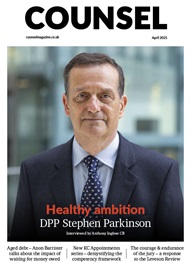*/
Edited by Chris Miele
Merrell Publishers; Hardback (April 2010); £35
ISBN: 1858945070
This book is one of the best things to come out of the transformation of the Middlesex Guildhall from a Crown Court into the Supreme Court. Lavishly illustrated with superb photographs, plans and drawings, it is also a wonderful read. There are eight essays from, amongst others, Lady Hale, Lord Bingham, and top notch art and architectural historians. Together they explain the judicial functions of the House of Lords leading to the creation of the Supreme Court, the history of the building and its predecessors on this site, the architecture of the present Guildhall together with its glorious decorative arts and sculpture inside and out, and the iconography of supreme courts in the common law world which over the decades has moved from imperial grandeur to glass box transparency.
There is also a fascinating history of Parliament Square itself through the centuries as it accidentally turned into a “traffic island laid out to display sculpture”. The present Mayor of London has shelved plans to turn this “a green glade of heroes into a vast, blasted chewing gummed piazza”.
Hugh Fielden, architect for the Supreme Court project, describes clearly how the team went about their task including their battles with the conservationists. Readers will decide whether they agree that “the cultural significance of the new Supreme Court outweighed the significance of the historic courtroom furniture”. This has largely been moved or dispersed in order to create the sort of court rooms which were deemed suitable for their new occupants.
The last word goes to HH Fabyan Evans, the penultimate presiding judge of Middlesex Crown Court, who describes the lost world of the 20th Century criminal practitioner before poignantly summing up the feelings of those who used and loved the building. He and Lord Bingham in particular know how not to waste a word in what they say. It doubtless was a particular challenge to edit eight such well qualified authors but there is the slight irritation that sometimes the same insight winds up being repeated by someone else in another chapter. The only thing missing is what it has been like to use the building.
There is also a fascinating history of Parliament Square itself through the centuries as it accidentally turned into a “traffic island laid out to display sculpture”. The present Mayor of London has shelved plans to turn this “a green glade of heroes into a vast, blasted chewing gummed piazza”.
Hugh Fielden, architect for the Supreme Court project, describes clearly how the team went about their task including their battles with the conservationists. Readers will decide whether they agree that “the cultural significance of the new Supreme Court outweighed the significance of the historic courtroom furniture”. This has largely been moved or dispersed in order to create the sort of court rooms which were deemed suitable for their new occupants.
The last word goes to HH Fabyan Evans, the penultimate presiding judge of Middlesex Crown Court, who describes the lost world of the 20th Century criminal practitioner before poignantly summing up the feelings of those who used and loved the building. He and Lord Bingham in particular know how not to waste a word in what they say. It doubtless was a particular challenge to edit eight such well qualified authors but there is the slight irritation that sometimes the same insight winds up being repeated by someone else in another chapter. The only thing missing is what it has been like to use the building.
Edited by Chris Miele
Merrell Publishers; Hardback (April 2010); £35
ISBN: 1858945070
This book is one of the best things to come out of the transformation of the Middlesex Guildhall from a Crown Court into the Supreme Court. Lavishly illustrated with superb photographs, plans and drawings, it is also a wonderful read. There are eight essays from, amongst others, Lady Hale, Lord Bingham, and top notch art and architectural historians. Together they explain the judicial functions of the House of Lords leading to the creation of the Supreme Court, the history of the building and its predecessors on this site, the architecture of the present Guildhall together with its glorious decorative arts and sculpture inside and out, and the iconography of supreme courts in the common law world which over the decades has moved from imperial grandeur to glass box transparency.


Now is the time to tackle inappropriate behaviour at the Bar as well as extend our reach and collaboration with organisations and individuals at home and abroad
A comparison – Dan Monaghan, Head of DWF Chambers, invites two viewpoints
And if not, why not? asks Louise Crush of Westgate Wealth Management
Marie Law, Head of Toxicology at AlphaBiolabs, discusses the many benefits of oral fluid drug testing for child welfare and protection matters
To mark International Women’s Day, Louise Crush of Westgate Wealth Management looks at how financial planning can help bridge the gap
Casey Randall of AlphaBiolabs answers some of the most common questions regarding relationship DNA testing for court
Maria Scotland and Niamh Wilkie report from the Bar Council’s 2024 visit to the United Arab Emirates exploring practice development opportunities for the England and Wales family Bar
Marking Neurodiversity Week 2025, an anonymous barrister shares the revelations and emotions from a mid-career diagnosis with a view to encouraging others to find out more
David Wurtzel analyses the outcome of the 2024 silk competition and how it compares with previous years, revealing some striking trends and home truths for the profession
Save for some high-flyers and those who can become commercial arbitrators, it is generally a question of all or nothing but that does not mean moving from hero to zero, says Andrew Hillier